Analysis and Design of a New High Voltage Gain Interleaved DC–DC Converter with Three-Winding Coupled Inductors for Renewable Energy Systems
Abstract
1. Introduction
- (1)
- The high voltage gain of the proposed converter can be obtained with an appropriate duty ratio.
- (2)
- Low voltage-rated MOSFETs with low on-state resistance RDS(ON) and low voltage-rated diodes with low forward voltage drop can be adopted to reduce conduction losses, due to their having low voltage stresses.
- (3)
- The switches turn ON under the ZCS condition to reduce switching losses.
- (4)
- The diode reverse–recovery issue is mitigated due to the leakage inductors of the coupled inductors, and voltage spikes on the switches are avoided because the leakage energy is recycled.
- (5)
- The interleaved parallel input structure of the presented configuration decreases current stresses on the power devices and reduces the input current ripple.
2. Proposed Converter and Principle of Operation
2.1. Proposed Converter
2.2. Operational Principle
- All semiconductors (switches and diodes) are considered to be ideal.
- All capacitors are sufficiently large, and the voltages on these capacitors are regarded as constant during one switching period.
- The parameters of the three-winding coupled inductors are regarded as being identical; that is, the turns ratio , and . The coupling coefficient of the coupled inductor is defined as .
3. Steady-State Analysis
3.1. Voltage Gain Analysis
3.2. Voltage Stress Analysis
3.3. Design Consideration
3.3.1. Considerations of Coupled Inductor Design
3.3.2. Considerations regarding Capacitor Design
3.4. Converter Performance Comparison
4. Driving Circuit and Controller Design
- A gain crossover frequency of 1 kHz ().
- A phase margin (P.M.) larger than .
- The low frequency gain of the open-loop transfer function to be very high to reduce the steady-state error for the constant reference input.
5. Experimental Results
6. Conclusions
Author Contributions
Funding
Data Availability Statement
Conflicts of Interest
References
- Nouri, T.; Nouri, N.; Vosoughi, N. A novel high step-up high efficiency interleaved DC-DC Converter with coupled inductor and built-in transformer for renewable energy systems. IEEE Trans. Ind. Electron. 2020, 67, 6505–6516. [Google Scholar] [CrossRef]
- Tofoli, F.L.; Pereira, D.C.; Paula, W.J.; Junior, D.S.O. Survey on non-isolated high-voltage step-up DC–DC topologies based on the boost converter. IET Power Electron. 2015, 8, 2044–2057. [Google Scholar] [CrossRef]
- Kothapalli, K.R.; Ramteke, M.R.; Suryawanshi, H.M.; Reddi, N.K.; Kalahasthi, R.B. A coupled inductor based high step-up converter for dc microgrid applications. IEEE Trans. Ind. Electron. 2021, 68, 4927–4940. [Google Scholar] [CrossRef]
- Liu, H.; Hu, H.; Wu, H.; Xing, Y.; Batarseh, I. Overview of high-step-up coupled-inductor boost converters. IEEE Trans. Power Electron. 2016, 4, 689–704. [Google Scholar] [CrossRef]
- Azizkandi, M.E.; Sedaghati, F.; Shayeghi, H.; Blaabjerg, F. Two- and three-winding coupled-inductor based high step-up DC-DC converters for sustainable energy applications. IET Power Electron. 2020, 13, 144–156. [Google Scholar] [CrossRef]
- Pereira, A.V.C.; Cavalcanti, M.C.; Azevedo, G.M.; Bradaschia, F.; Neto, R.C.; Carvalho, M.R.S. A novel single-switch high step-up dc–dc converter with three-winding coupled inductor. Energies 2021, 14, 6288. [Google Scholar] [CrossRef]
- Li, W.; Zhao, Y.; Wu, J.; He, X. Interleaved high step-up converter with winding-cross-coupled inductors and voltage multiplier cells. IEEE Trans. Power Electron. 2012, 27, 133–143. [Google Scholar] [CrossRef]
- Barbosa, E.A.O.; Carvalho, M.R.S.; Limongi, L.R.; Cavalcanti, M.C.; Barbosa, E.J.; Azevedo, G.M.S. High-gain high-efficiency DC-DC converter with single-core parallel operation switched inductors and rectifier voltage multiplier cell. Energies 2021, 14, 4634. [Google Scholar] [CrossRef]
- Schmitz, L.; Martins, D.C.; Coelho, R.F. Comprehensive conception of high step-up DC-DC converters with coupled inductor and voltage multiplier techniques. IEEE Trans. Circuits Syst. 2020, 67, 2140–2151. [Google Scholar] [CrossRef]
- Alzahrani, A.; Ferdowsi, M.; Shamsi, P. A Family of scalable non-isolated interleaved DC-DC boost converters with voltage multiplier cells. IEEE Access 2019, 7, 11707–11721. [Google Scholar] [CrossRef]
- Andrade, A.M.; Mattos, E.; Schuch, L.; Hey, H.L.; Martions, M.L.D.S. Synthesis and comparative analysis of very high step-up DC-DC converters adopting coupled-inductor and voltage multiplier cells. IEEE Trans. Power Electron. 2018, 33, 5880–5897. [Google Scholar] [CrossRef]
- Nouri, T.; Vosoughi, N.; Hosseini, S.H.; Babaei, E.; Sabahi, M. An interleaved high step-up converter with coupled inductor and built-in transformer voltage multiplier cell techniques. IEEE Trans. Ind. Electron. 2019, 66, 1894–1905. [Google Scholar] [CrossRef]
- Guepfrih, M.F.; Waltrich, G.; Lazzarin, T.B. High step-up DC–DC converter using built-in transformer voltage multiplier cell and dual boost concepts. IEEE J. Emerg. Sel. Top. Power Electron. 2021, 9, 6700–6712. [Google Scholar] [CrossRef]
- Tang, Y.; Fu, D.; Wang, T.; Xu, Z. Hybrid switched-inductor converters for high step-up conversion. IEEE Trans. Ind. Electron. 2015, 62, 1480–1490. [Google Scholar] [CrossRef]
- Andrade, J.M.; Coelho, R.F.; Lazzarin, T.B. High step-up DC–DC converter based on modified active switched-inductor and switched-capacitor cells. IET Power Electron. 2020, 13, 3127–3137. [Google Scholar] [CrossRef]
- Salvador, M.A.; Lazzarin, T.B.; Coelho, R.F. High step-up DC-DC converter with active switched-inductor and passive switched-capacitor networks. IEEE Trans. Ind. Electron. 2018, 65, 5644–5654. [Google Scholar] [CrossRef]
- Salvador, M.A.; Andrade, J.M.; Lazzarin, T.B.; Coelho, R.F. Nonisolated high-step-up DC-DC converter derived from switched-inductors and switched-capacitors. IEEE Trans. Ind. Electron. 2020, 67, 8506–8516. [Google Scholar] [CrossRef]
- Duong, T.D.; Nguyen, M.K.; Tran, T.T.; Lim, Y.C.; Choi, J.H. Transformer-less switched-capacitor quasi-switched boost DC-DC converter. Energies 2021, 14, 6591. [Google Scholar] [CrossRef]
- Taghavi, S.S.; Rezvanyvardom, M.; Mirzaei, A.; Gorji, S.A. High step-up three-level soft switching DC-DC converter for photovoltaic generation systems. Energies 2023, 16, 41. [Google Scholar] [CrossRef]
- Rodrigues, J.P.; Mussa, S.A.; Barbi, I.; Perin, A.J. Three-level zero-voltage switching pulse-width modulation DC-DC boost converter with active clamping. IET Power Electron. 2010, 3, 345–354. [Google Scholar] [CrossRef]
- He, L.; Xu, X.; Chen, J.; Sun, J.; Guo, D.; Zeng, T. A plug-play active resonant soft switching for current-autobalance interleaved high step-up DC-DC converter. IEEE Trans. Power Electron. 2019, 34, 7603–7616. [Google Scholar] [CrossRef]
- Eskandari1, R.; Babaei, E.; Sabahil, M.; Ojaghkandi, S.R. Interleaved high step-up zero-voltage zero current switching boost DC-DC converter. IET Power Electron. 2020, 13, 96–103. [Google Scholar] [CrossRef]
- Khorasani, R.R.; Jazi, H.M.; Chaudhuri, N.R.; Sadigh, A.K.; Shaneh, M. An interleaved soft switched high step-up boost converter with high power density for renewable energy applications. IEEE Trans. Power Electron. 2022, 37, 13782–13798. [Google Scholar] [CrossRef]
- Carvalho, M.R.S.; Neto, R.C.; Barbosa, E.J.; Limongi, L.R.; Bradaschia, F.; Cavalcanti, M.C. An overview of voltage boosting techniques and step-up DC-DC converters topologies for pv applications. Energies 2021, 14, 8230. [Google Scholar] [CrossRef]
- Arunkumari, T.; Indragandhi, V. An overview of high voltage conversion ratio DC-DC converter configurations used in DC micro-grid architectures. Renew. Sustain. Energy Rev. 2017, 77, 670–687. [Google Scholar] [CrossRef]
- Forouzesh, M.; Siwakoti, Y.P.; Gorji, S.A.; Lehmen, B. Step-up DC-DC comprehensive review of voltage-boosting techniques, topologies, and applications. IEEE Trans. Ind. Electron. 2017, 32, 9143–9178. [Google Scholar] [CrossRef]
- Guan, Y.; Cecati, C.; Alonso, J.M.; Zhang, Z. Review of high-frequency high-voltage-conversion-ratio DC-DC converters. IEEE Trans. Ind. Electron. 2021, 2, 374–389. [Google Scholar] [CrossRef]
- Nouri, T.; Hosseini, S.H.; Babaei, E.; Ebrahimi, J. Interleaved high step-up DC-DC converter based on three-winding high-frequency coupled inductor and voltage multiplier cell. IET Power Electron. 2015, 8, 175–189. [Google Scholar] [CrossRef]
- He, L.; Liao, Y. An advanced current-autobalance high step-up converter with a multicoupled inductor and voltage multiplier for a renewable power generation system. IEEE Trans. Power Electron. 2016, 31, 6992–7005. [Google Scholar]
- Chen, S.J.; Yang, S.P.; Huang, C.M.; Chou, H.M.; Shen, M.J. Interleaved high step-up DC-DC converter based on voltage multiplier cell and voltage-stacking techniques for renewable energy applications. Energies 2018, 11, 1632. [Google Scholar] [CrossRef]
- Salehi, S.M.; Dehghan, S.M.; Hasanzadeh, S. Interleaved-input series output ultra-high voltage gain DC-DC converter. IEEE Trans. Power Electron. 2019, 34, 3397–3406. [Google Scholar] [CrossRef]
- Chen, S.J.; Yang, S.P.; Huang, C.M.; Chen, Y.H. Interleaved high step-up DC-DC converter with voltage-lift and voltage-stack techniques for photovoltaic systems. Energies 2020, 13, 2537. [Google Scholar] [CrossRef]
- Rahimi, R.; Habibi, S.; Ferdowsi, M.; Shamsi, P. A three-winding coupled inductor-based interleaved high-voltage gain DC-DC converter for photovoltaic systems. IEEE Trans. Power Electron. 2022, 37, 990–1002. [Google Scholar] [CrossRef]
- Venable, D. The K factor: A new mathematical tool for stability analysis and synthesis. Proc. Powercon 1983, 10, 1–12. [Google Scholar]

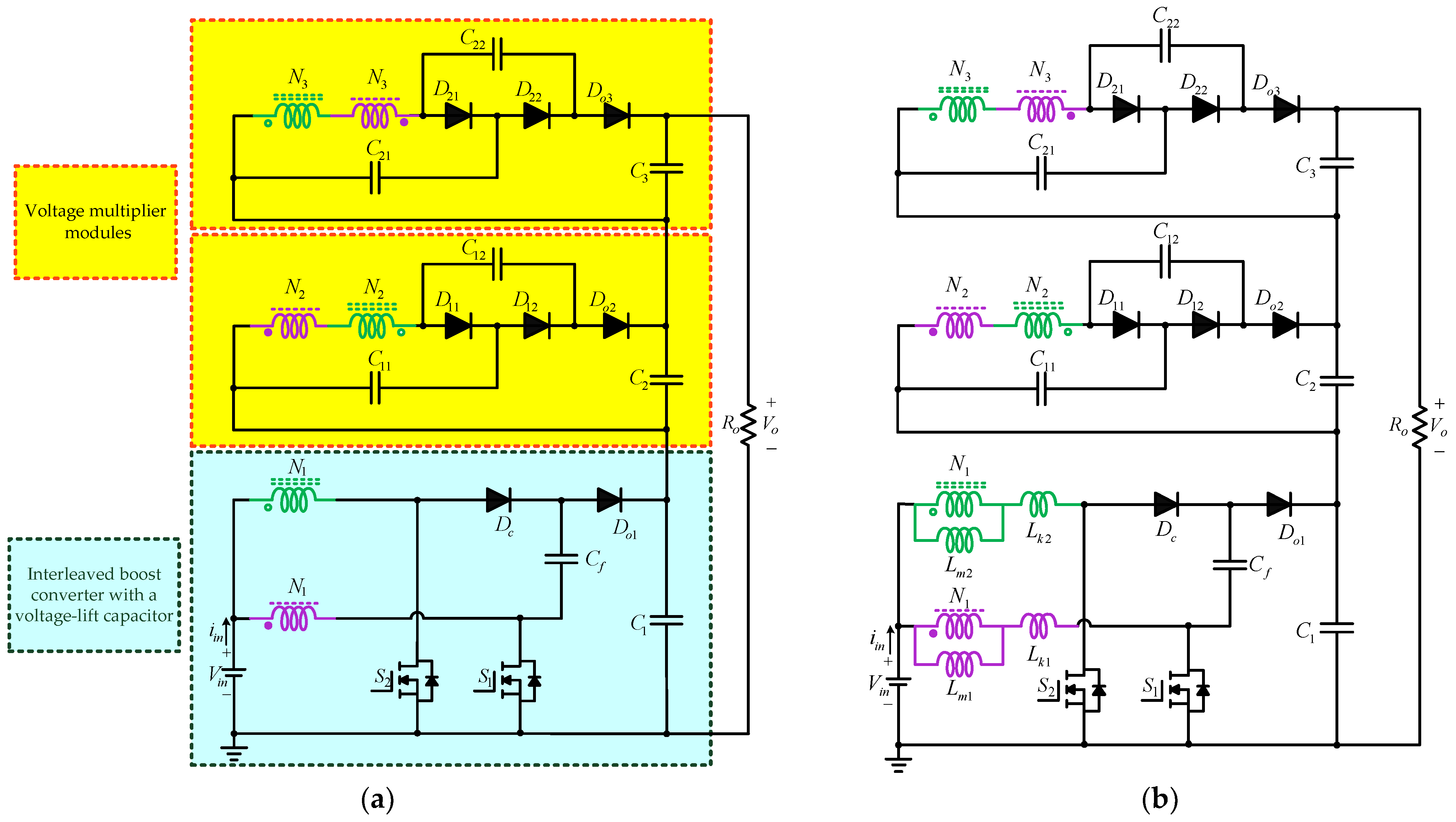
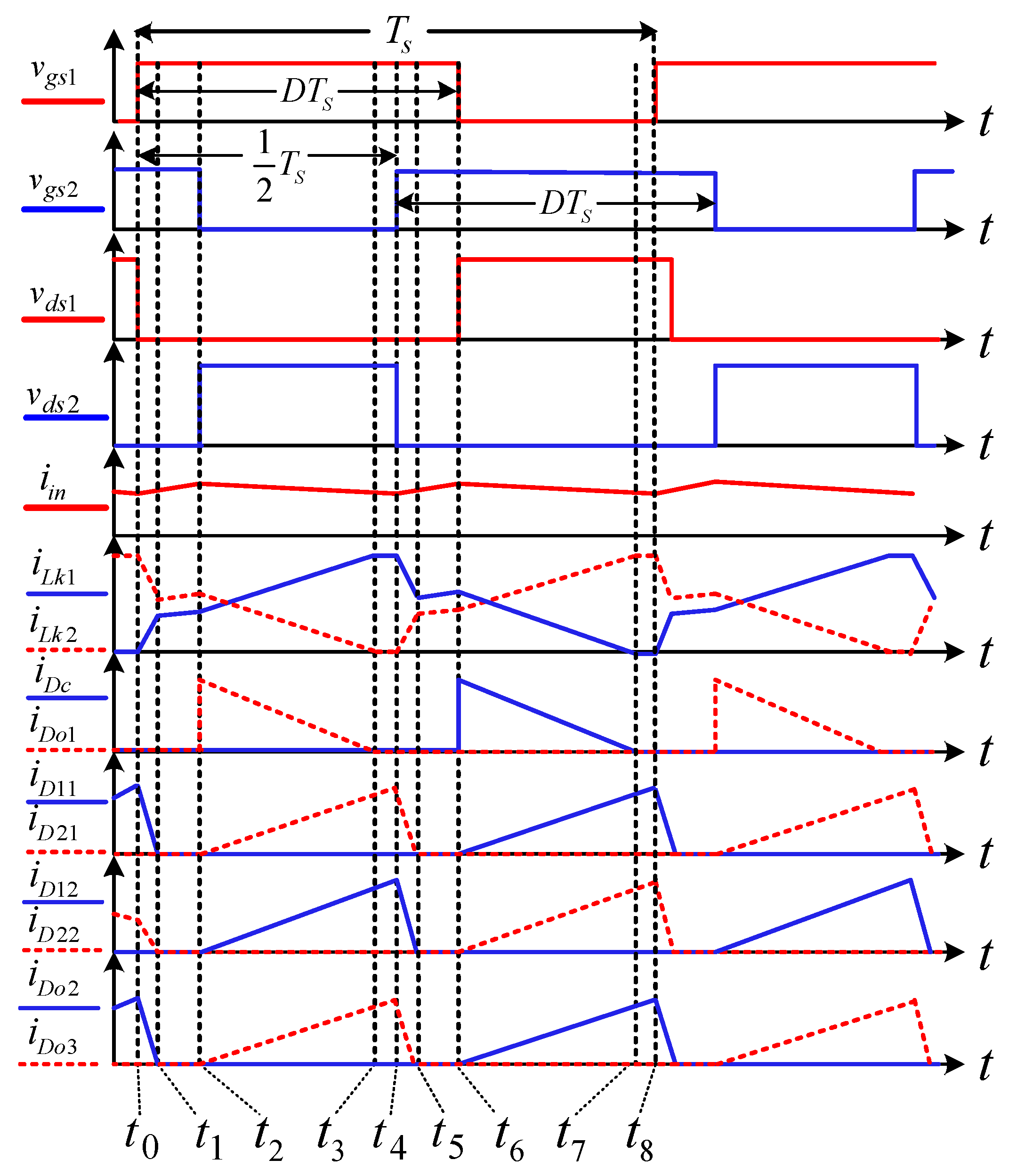
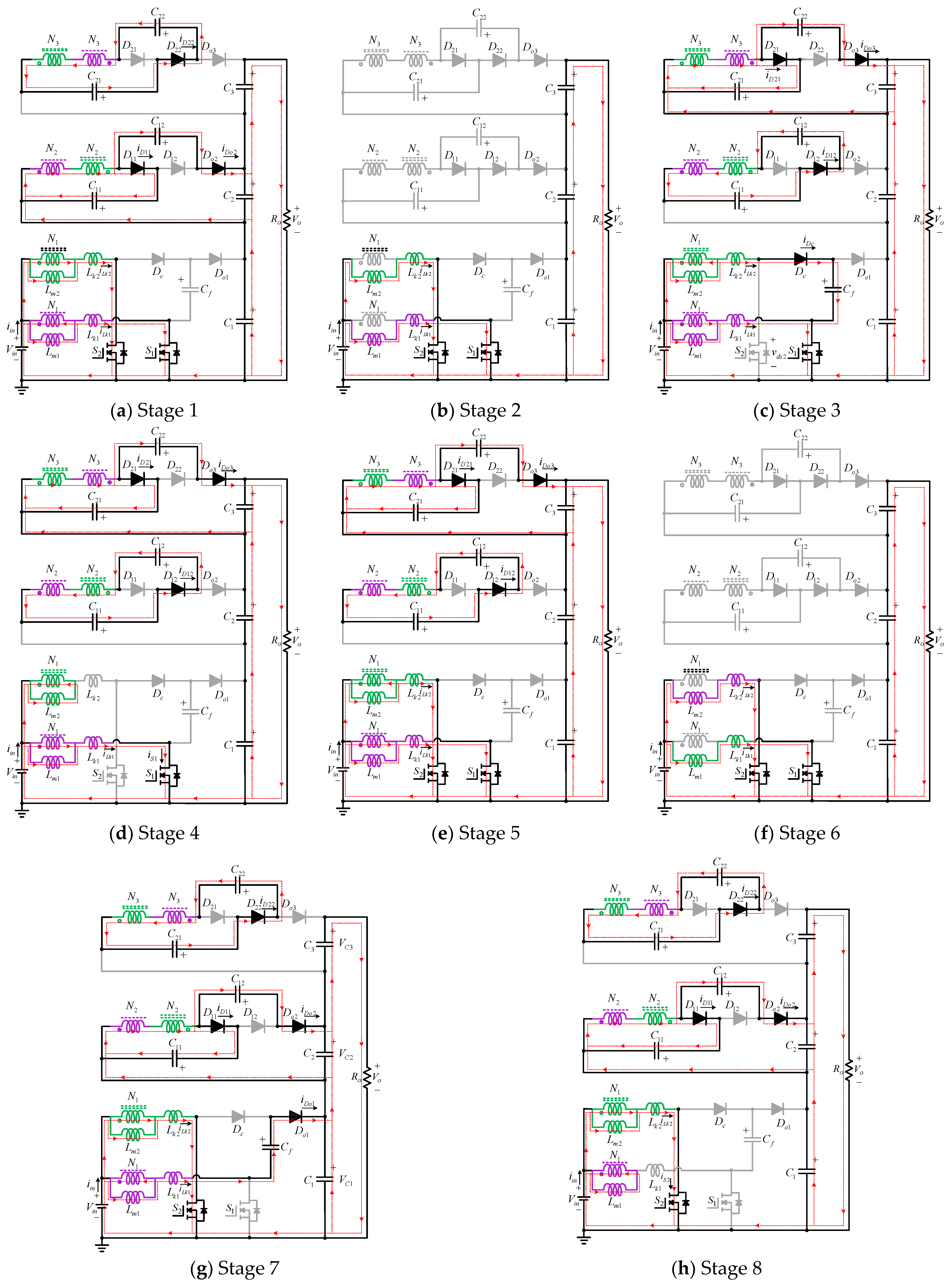

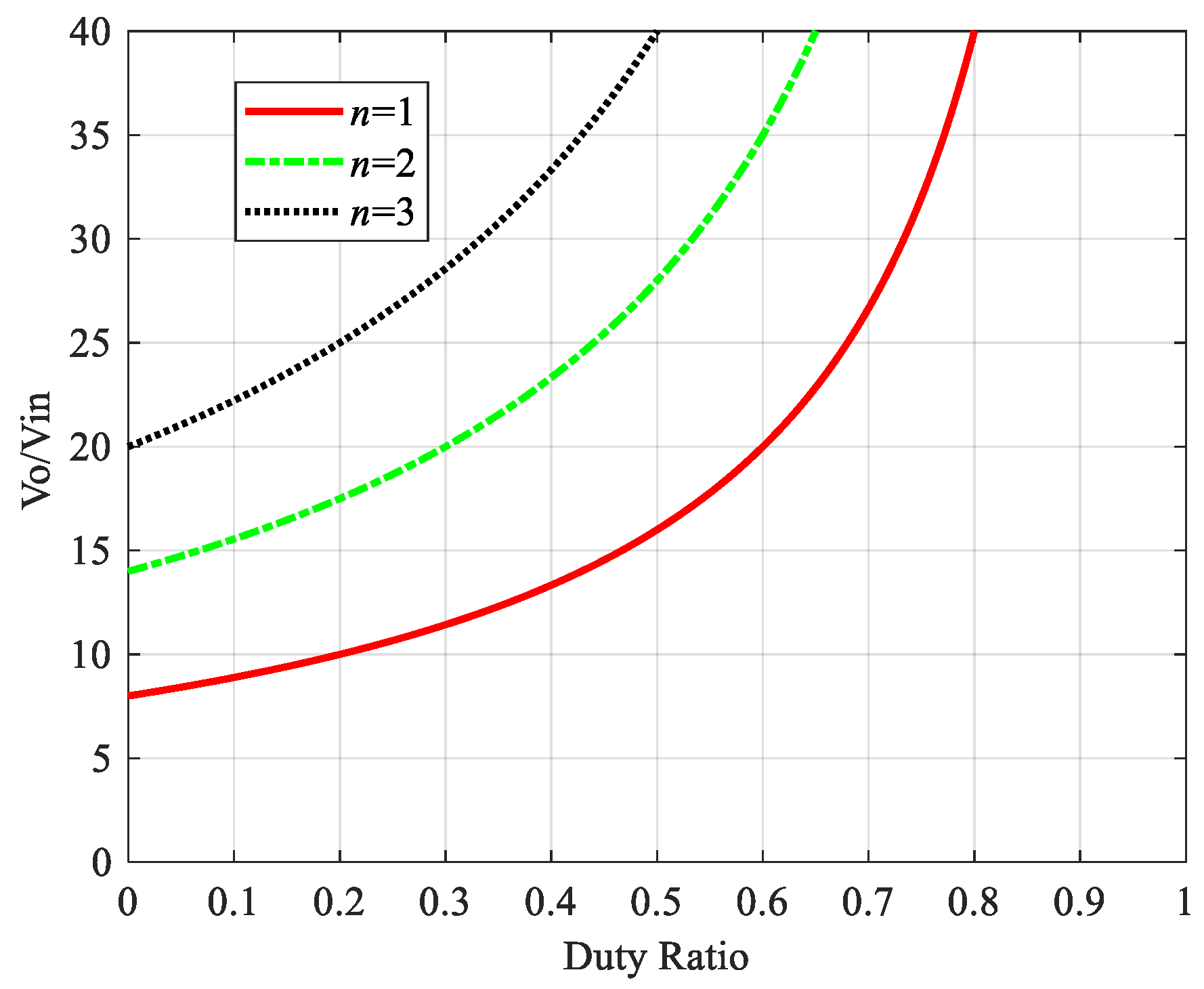
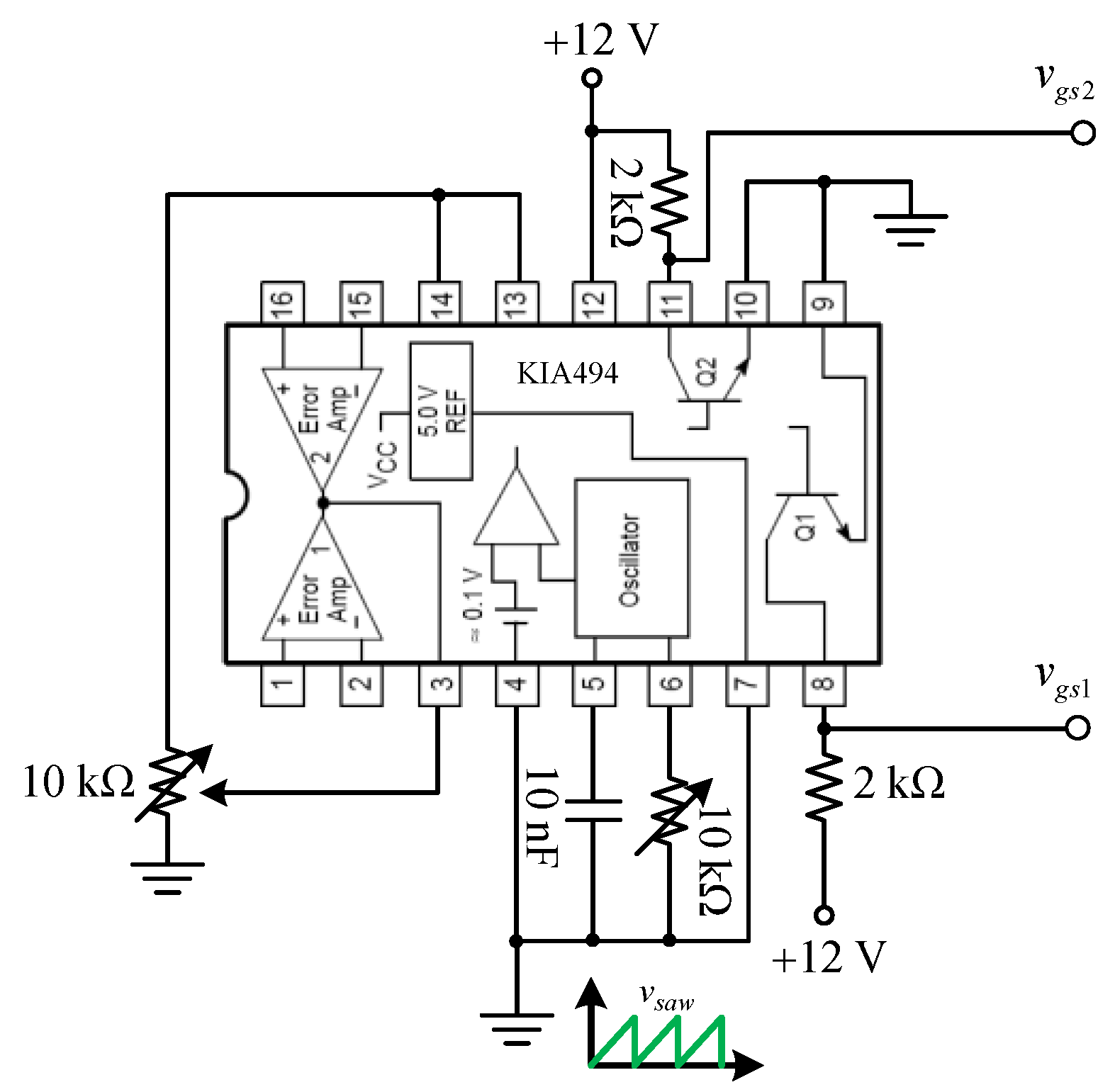



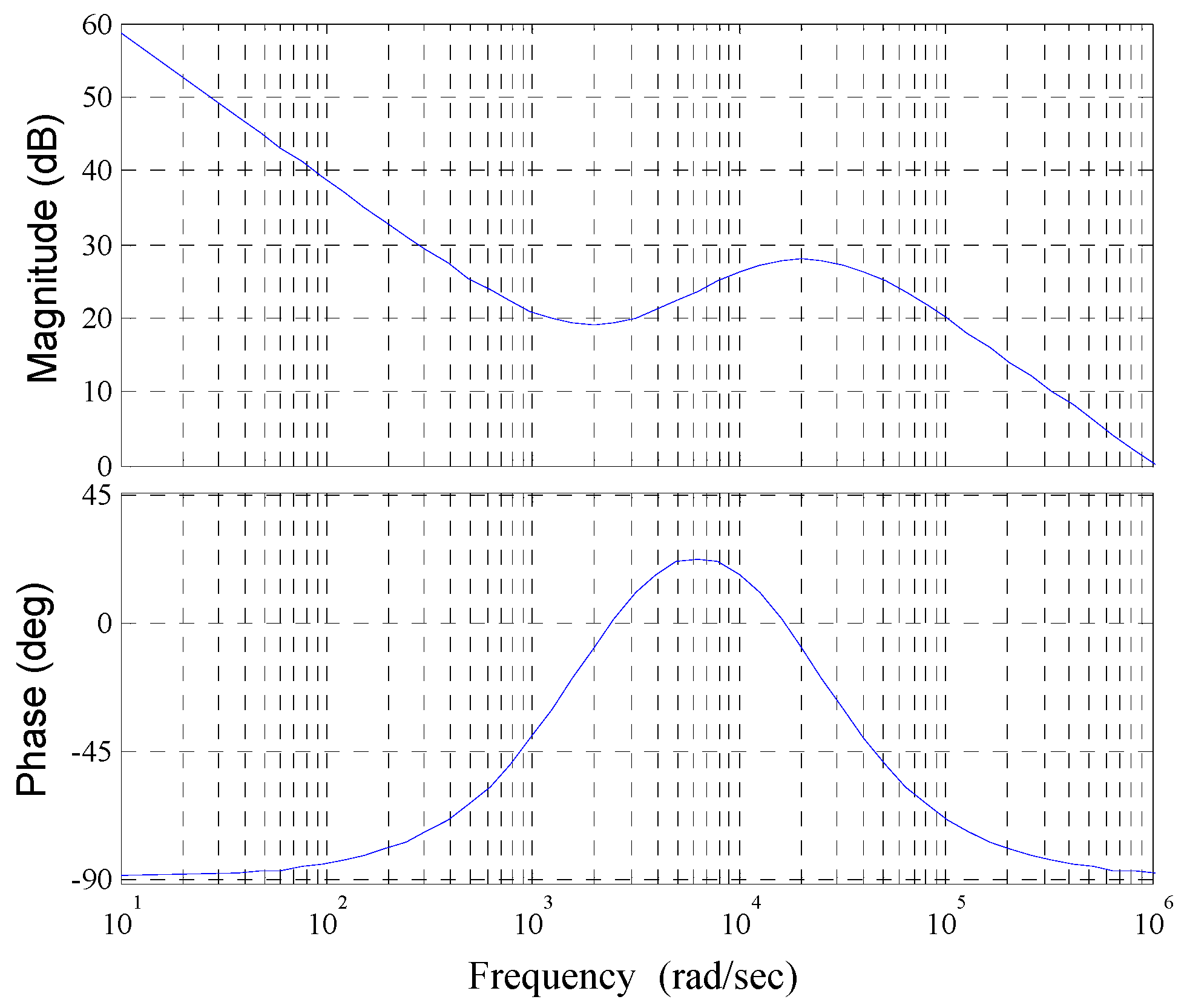

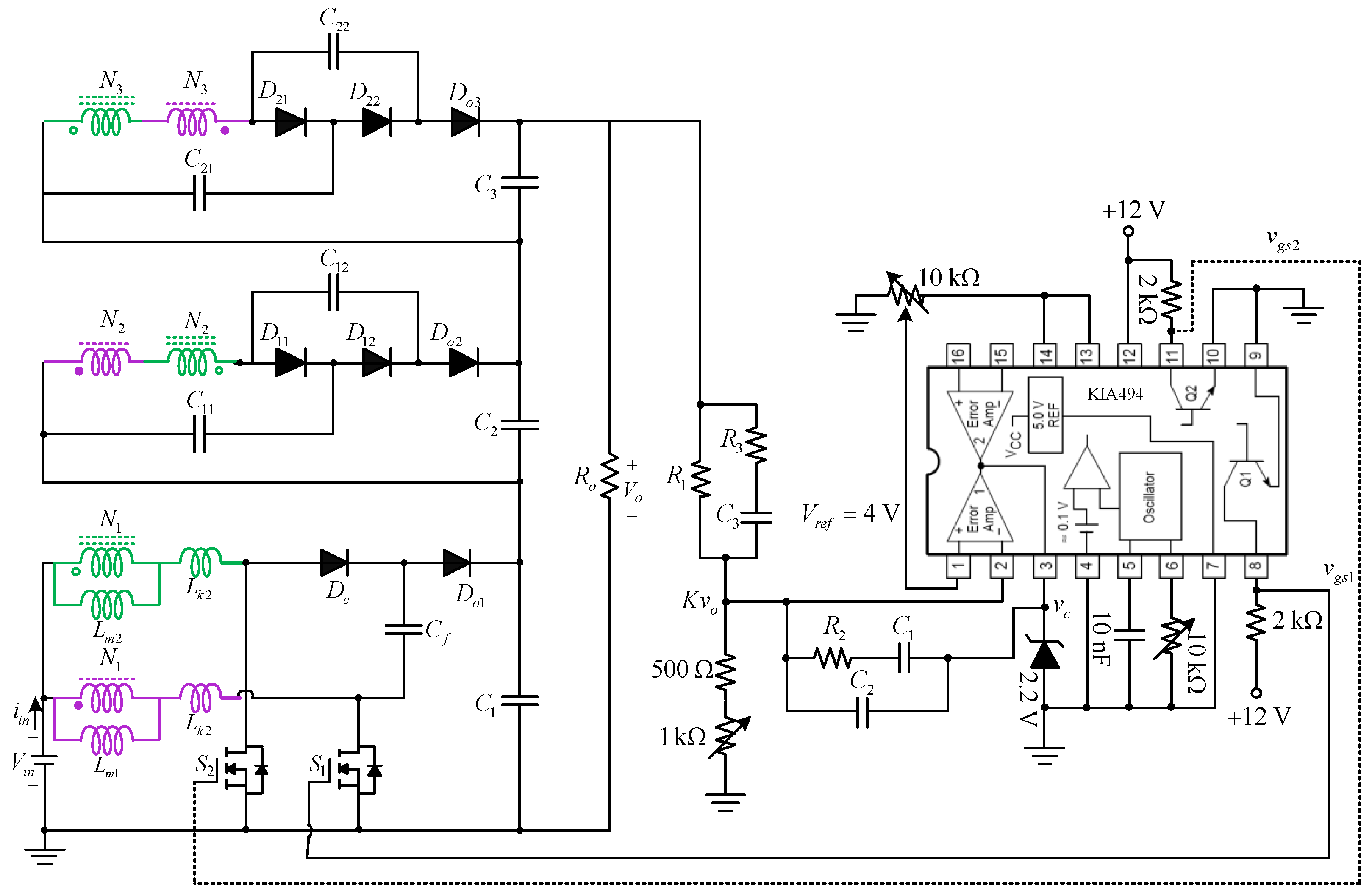

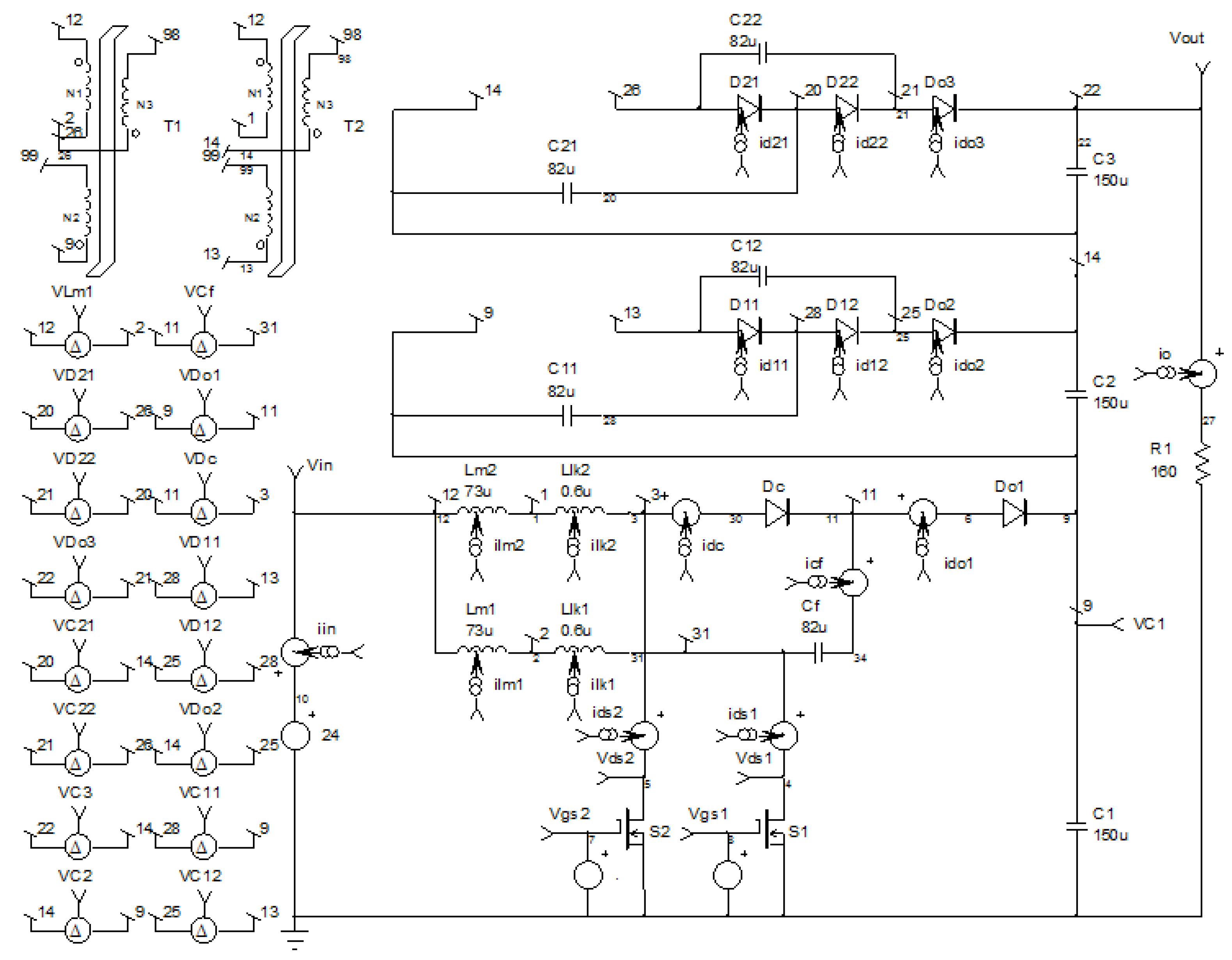





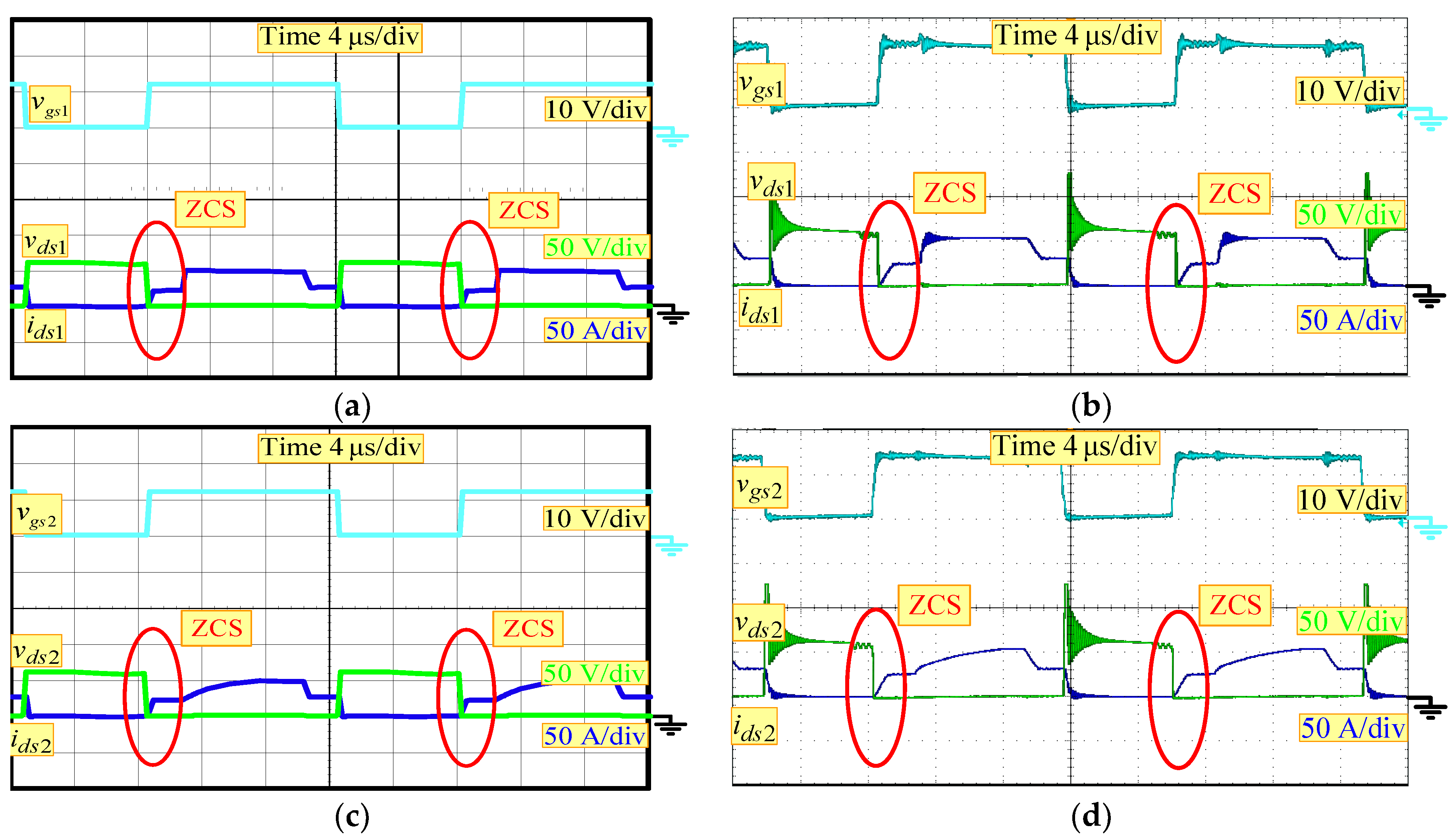



| Reference Converter | [28] | [29] | [30] | [31] | [32] | [33] | Proposed |
|---|---|---|---|---|---|---|---|
| Voltage gain | |||||||
| Voltage stress on switches | |||||||
| Maximum diode voltage stress | |||||||
| Number of switches | 2 | 2 | 2 | 2 | 2 | 2 | 2 |
| Number of diodes | 8 | 6 | 6 | 9 | 7 | 5 | 8 |
| Number of capacitors | 7 | 5 | 6 | 8 | 6 | 5 | 8 |
| Number of coupled inductor | 2 | 2 | 2 | 2 | 2 | 2 | 2 |
| Voltage gain | 10 | 10 | 15 | 14 | 15 | 20 | 20 |
| Components | Parameters |
|---|---|
| Magnetizing inductors , | |
| Leakage inductors , | |
| Turns ratio of coupled inductor | |
| Voltage-lift capacitor | |
| Output capacitors , , | |
| Regenerative capacitors , | |
| Voltage-doubler capacitors , | |
| Switching frequency | |
| Switches , | FDP036N10A |
| Diodes , , , , , | V30120C |
| Diodes , | 30CPQ200 |
Disclaimer/Publisher’s Note: The statements, opinions and data contained in all publications are solely those of the individual author(s) and contributor(s) and not of MDPI and/or the editor(s). MDPI and/or the editor(s) disclaim responsibility for any injury to people or property resulting from any ideas, methods, instructions or products referred to in the content. |
© 2023 by the authors. Licensee MDPI, Basel, Switzerland. This article is an open access article distributed under the terms and conditions of the Creative Commons Attribution (CC BY) license (https://creativecommons.org/licenses/by/4.0/).
Share and Cite
Chen, S.-J.; Yang, S.-P.; Huang, C.-M.; Huang, P.-S. Analysis and Design of a New High Voltage Gain Interleaved DC–DC Converter with Three-Winding Coupled Inductors for Renewable Energy Systems. Energies 2023, 16, 3958. https://doi.org/10.3390/en16093958
Chen S-J, Yang S-P, Huang C-M, Huang P-S. Analysis and Design of a New High Voltage Gain Interleaved DC–DC Converter with Three-Winding Coupled Inductors for Renewable Energy Systems. Energies. 2023; 16(9):3958. https://doi.org/10.3390/en16093958
Chicago/Turabian StyleChen, Shin-Ju, Sung-Pei Yang, Chao-Ming Huang, and Ping-Sheng Huang. 2023. "Analysis and Design of a New High Voltage Gain Interleaved DC–DC Converter with Three-Winding Coupled Inductors for Renewable Energy Systems" Energies 16, no. 9: 3958. https://doi.org/10.3390/en16093958
APA StyleChen, S.-J., Yang, S.-P., Huang, C.-M., & Huang, P.-S. (2023). Analysis and Design of a New High Voltage Gain Interleaved DC–DC Converter with Three-Winding Coupled Inductors for Renewable Energy Systems. Energies, 16(9), 3958. https://doi.org/10.3390/en16093958








